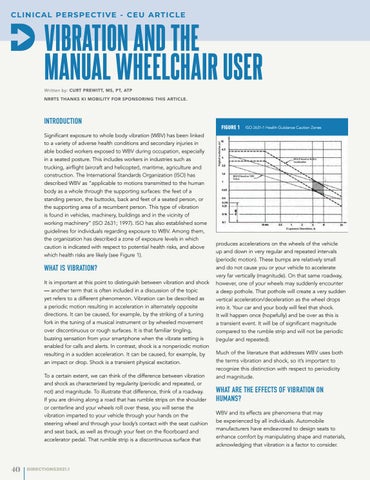CL I N ICA L PE RSPECT IVE - C E U ARTI CLE
VIBRATION AND THE MANUAL WHEELCHAIR USER Written by: CURT PREWITT, MS, PT, ATP NRRTS THANKS KI MOBILITY FOR SPONSORING THIS ARTICLE.
INTRODUCTION Significant exposure to whole body vibration (WBV) has been linked to a variety of adverse health conditions and secondary injuries in able bodied workers exposed to WBV during occupation, especially in a seated posture. This includes workers in industries such as trucking, airflight (aircraft and helicopter), maritime, agriculture and construction. The International Standards Organization (ISO) has described WBV as “applicable to motions transmitted to the human body as a whole through the supporting surfaces: the feet of a standing person, the buttocks, back and feet of a seated person, or the supporting area of a recumbent person. This type of vibration is found in vehicles, machinery, buildings and in the vicinity of working machinery” (ISO 2631; 1997). ISO has also established some guidelines for individuals regarding exposure to WBV. Among them, the organization has described a zone of exposure levels in which caution is indicated with respect to potential health risks, and above which health risks are likely (see Figure 1).
WHAT IS VIBRATION? It is important at this point to distinguish between vibration and shock — another term that is often included in a discussion of the topic yet refers to a different phenomenon. Vibration can be described as a periodic motion resulting in acceleration in alternately opposite directions. It can be caused, for example, by the striking of a tuning fork in the tuning of a musical instrument or by wheeled movement over discontinuous or rough surfaces. It is that familiar tingling, buzzing sensation from your smartphone when the vibrate setting is enabled for calls and alerts. In contrast, shock is a nonperiodic motion resulting in a sudden acceleration. It can be caused, for example, by an impact or drop. Shock is a transient physical excitation. To a certain extent, we can think of the difference between vibration and shock as characterized by regularity (periodic and repeated, or not) and magnitude. To illustrate that difference, think of a roadway. If you are driving along a road that has rumble strips on the shoulder or centerline and your wheels roll over these, you will sense the vibration imparted to your vehicle through your hands on the steering wheel and through your body’s contact with the seat cushion and seat back, as well as through your feet on the floorboard and accelerator pedal. That rumble strip is a discontinuous surface that
40
DIRECTIONS 2021.1
FIGURE 1
ISO 2631-1 Health Guidance Caution Zones
produces accelerations on the wheels of the vehicle up and down in very regular and repeated intervals (periodic motion). These bumps are relatively small and do not cause you or your vehicle to accelerate very far vertically (magnitude). On that same roadway, however, one of your wheels may suddenly encounter a deep pothole. That pothole will create a very sudden vertical acceleration/deceleration as the wheel drops into it. Your car and your body will feel that shock. It will happen once (hopefully) and be over as this is a transient event. It will be of significant magnitude compared to the rumble strip and will not be periodic (regular and repeated). Much of the literature that addresses WBV uses both the terms vibration and shock, so it’s important to recognize this distinction with respect to periodicity and magnitude.
WHAT ARE THE EFFECTS OF VIBRATION ON HUMANS? WBV and its effects are phenomena that may be experienced by all individuals. Automobile manufacturers have endeavored to design seats to enhance comfort by manipulating shape and materials, acknowledging that vibration is a factor to consider.









